Analytical Investigation of the Heat-Transfer Limits of a Novel Solar Loop-Heat Pipe Employing a Mini-Channel Evaporator
Abstract
:1. Introduction
2. Methods
LHP System Description and Operation
3. Mathematical Equations for Heat-Transfer Limits
3.1. Viscous Limit QVL
3.2. Sonic Limit QSL
3.3. Entrainment Limit QEL
3.4. Boiling Limit QBL
3.5. Pressure-Drop Limit QPL
3.6. Algorithm for the Computer Model
- Given the geometry of the solar LHP, technical parameters are presented in Table 1.
- Given a certain operating temperature, the thermodynamic properties of the refrigerant are estimated.
- Calculating the viscous limits at an appropriate region in the operation, and taking the minimum value as the viscous limit by Equations (1) and (9).
- Calculating the sonic limit at an appropriate region in the operation, and taking the minimum value as the sonic limit by Equations (10) and (11).
- Calculating the entrainment limits at an appropriate region in the operation, and taking the minimum value as the entrainment limit by Equations (12)–(14).
- Calculating the boiling limits at an appropriate region in the operation, and taking the minimum value as the boiling limit by Equations (15), (17) and (18).
- Running a numerical iteration to calculate the pressure-drop limit.
- (a)
- Given the initial value of QPL.
- (b)
- Gravity pressure is estimated Pg by Equation (20).
- (c)
- Total pressure drop in the loop is estimated Pt by Equation (19).
- (d)
- If [(Pg − Pt)/Pg] < −0.5% (error allowance), then decrease QPL by 10.
- (e)
- If [(Pg − Pt)/Pg] > −0.5% (error allowance), then increase QPL by 10.
- (f)
- If −0.5% ≤ [(PG − Pt)/Pg] ≤ 0.5% (error allowance), heat balance is achieved and real value of QPL can be obtained.
- Taking the minimum value, the five limits as the governing limit of the system operation.
- Program stops.
4. Results and Discussion
4.1. The Impact of the Operating Temperature of the Mini-Channel Evaporator
4.2. The Impact of the Heat Pipe Aspect Ratio
4.3. The Impact of the Condenser-to-Absorber Height Difference
4.4. Impact of the Individual Hole’s Dimension
4.5. Impact of the Evaporator Inclination Angle
4.6. Impact of the Evaporator Length
5. Conclusions
Acknowledgments
Author Contributions
Conflicts of Interest
Nomenclature
| A | cross-section | [m2] |
| a | mini-channel width | [m] |
| b | mini-channel height | [m] |
| Bo | Bond number | [-] |
| Cd | discharge coefficient | [-] |
| D | diameter | [m] |
| Dh | hydraulic diameter | [m] |
| f | Fanning friction factor | [-] |
| f1 | factor 1 | [-] |
| f2 | factor 2 | [-] |
| f3 | factor 3 | [-] |
| g | gravitational acceleration | 9.81 [m/s2] |
| G | mass velocity | [kg/m2/s] |
| H | height | [m] |
| hfg | latent heat of vaporisation | [J/kg] |
| L | length | [m] |
| M | Mach number | [-] |
| N | number | [-] |
| Nch | number channel ports | [-] |
| P | pressure | [Pa] |
| ΔP | pressure drop | [Pa] |
| Q | heat-transfer limit | [W] |
| rb | critical radius of bubble generation | [m] |
| R | specific gas constant | [J/(kg K)] |
| Re | Reynolds number | [-] |
| t/T | temperature | [°C/°K] |
| U | superficial velocity | [m/s] |
| v | velocity | [m/s] |
| x | vapour quality | [-] |
Subscripts
| A | accelerational |
| BL | boiling limit |
| ch | channel |
| cond | condenser |
| F | frictional |
| e | evaporator |
| EL | entrainment limit |
| f | fluid |
| F | frictional |
| fg | fluid gas |
| g | gravity |
| G | gravitational |
| h | hole |
| he | heat exchanger |
| hp | heat pipe |
| hp-he | heat-pipe-to-heat-exchanger |
| i | inner |
| k | liquid or vapour |
| lf | liquid film |
| lh | liquid header |
| LO | liquid only |
| ltl | liquid transportation line |
| l | liquid |
| o | outer |
| p | ports |
| PL | pressure limit |
| SL | sonic limit |
| t | total |
| tp | two-phase |
| v | vapour |
| vh | vapour header |
| VL | viscosity limit |
| VO | vapour only |
| vtl | vapour transportation line |
| w | water |
Greek Symbols
| α | void fraction | |
| β | inclination angle | [o] |
| Δ | difference | |
| γ | ratio of specific heat | |
| thermal conductivity | [W/(m·K)] | |
| μ | dynamic viscosity | [Pa·s] |
| ρ | density | [kg/m3] |
| liquid film thickness | [m] | |
| σ | surface tension | [N/m] |
| specific volume | [m3/kg] |
Appendix A
Appendix B
Appendix C
- , , .
- , .
- , .
- ,
Appendix D
References
- Launay, S.; Sartre, V.; Bonjour, J. Parametric analysis of loop heat pipe operation: A literature review. Int. J. Therm. Sci. 2007, 46, 621–636. [Google Scholar] [CrossRef]
- Bertela, M.; Prakash, J. Transport of thermal energy by a simple two-phase loop. Int. J. Energy Res. 1988, 12, 679–698. [Google Scholar] [CrossRef]
- Wang, Z.; Yang, W. A review on loop heat pipe for use in solar water heating. Energy Build. 2014, 79, 43–154. [Google Scholar] [CrossRef]
- Walker, A.; Mahjouri, F.; Stiteler, R. Evacuated Tube Heat-Pipe Solar Collectors Applied to the Recirculation Loop in A Federal Building; National Renewable Energy Lab.: Golden, CO, USA, 2004.
- Khairnasov, S.M.; Naumova, A.M. Heat pipes application to solar energy systems. Appl. Sol. Energy 2016, 52, 47–60. [Google Scholar] [CrossRef]
- Zhou, J.; Zhao, Z.; Ma, X.; Du, Z.; Fan, Y.; Cheng, Y.; Zhang, X. Clear-days operational performance of a hybrid experimental space heating system employing the novel mini-channel solar thermal & PV/T panels and a heat pump. Sol. Energy 2017, 155, 464–477. [Google Scholar]
- Hou, L.; Quan, Z.; Zhao, Y.; Wang, L.; Wang, G. An experimental and simulative study on a novel photovoltaic-thermal collector with micro heat pipe array (MHPA-PV/T). Energy Build. 2016, 124, 60–69. [Google Scholar] [CrossRef]
- Hopkins, R.; Faghri, A.; Khrustalev, D. Flat Miniature Heat Pipes with Micro Capillary Grooves. J. Heat Transf. 1999, 121, 102–109. [Google Scholar] [CrossRef]
- Zhou, J.; Zhao, Z.; Ma, X.; Zhu, Z.; Qiu, Z.; Ji, J.; Du, Z.; Yu, M. Experimental investigation of a solar driven direct-expansion heat pump system employing the novel PV/micro-channels-evaporator modules. Appl. Energy 2016, 178, 484–495. [Google Scholar] [CrossRef]
- Deng, Y.; Zhao, Y.; Quan, Z.; Zhua, T. Experimental study of the thermal performance for the novel flat plate solar water heater with micro heat pipe array absorber. Energy Proc. 2015, 70, 41–48. [Google Scholar] [CrossRef]
- Deng, Y.; Zhao, Y.; Wang, W.; Quan, Z.; Wang, L.; Yu, D. Experimental investigation of performance for the novel flat plate solar collector with micro-channel heat pipe array (MHPA-FPC). Appl. Therm. Eng. 2013, 54, 440–449. [Google Scholar] [CrossRef]
- Zhu, T.; Diao, Y.; Zhao, Y.; Li, F. Thermal performance of a new CPC solar air collector with flat micro-heat pipe arrays. Appl. Therm. Eng. 2016, 98, 1201–1213. [Google Scholar] [CrossRef]
- Wang, Z.; Zhao, Z. Analytical study of the heat transfer limits of a novel loop heat pipe system. Int. J. Energy Res. 2011, 35, 404–414. [Google Scholar] [CrossRef]
- Zhang, X.; Zhao, X.; Xu, J.; Yu, X. Study of the heat transport capacity of a novel gravitational loop heat pipe. Int. J. Low Carbon Tech. 2013, 8, 210–223. [Google Scholar] [CrossRef]
- Kuroda, M.; Chang, J.; Gwin, P.; Mongia, R. Development of aluminium-water heat pipes. In Proceedings of the 17th International Heat Pipe Conference (17th IHPC), Kanpur, India, 13–17 October 2013. [Google Scholar]
- Ochterbeck, J.M. Heat Pipes Heat Transfer Handbook; Wiley: New York, NY, USA, 2003; Volume 1. [Google Scholar]
- Reay, D.; Kew, P. Heat Pipes Theory, Design and Applications, 5th ed.; Elsevier: Oxford, UK, 2006; ISBN 978-0-7506-6754. [Google Scholar]
- Imura, H.; Kusuda, H.; Funatsu, S. Flooding velocity in a counter-current annular two-phase flow. Chem. Eng. Sci. 1977, 32, 79–87. [Google Scholar] [CrossRef]
- Swamee, P.K.; Swamee, N. Discharge equation of a circular sharp-crested orifice. J. Hydraul. Res. 2010, 48, 106–107. [Google Scholar] [CrossRef]
- Grooten, M.H.M.; van der Geld, C.W.M. The Effect of the Angle of Inclination on the Operation Limiting Heat Flux of Long R-134a Filled Thermosyphon. J. Heat Transf. 2010, 132, 05150. [Google Scholar] [CrossRef]
- Milanez, H.F.; Mantelli, M.B.H. Heat transfer limit due to pressure drop of two-phase loop thermosiphon. Heat Pipe Sci. Technol. Int. J. 2010, 1, 237–250. [Google Scholar]
- Kim, S.M.; Mudawar, I. Universal approach to predicting two phase frictional pressure drop for mini/micro-channel saturated flow boiling. Int. J. Heat Mass Transf. 2013, 58, 718–734. [Google Scholar] [CrossRef]
- Riffat, S.B.; Zhao, X.; Doherty, P.S. Analytical and numerical simulation of the thermal performance of ‘mini’ gravitational and ‘micro’ gravitational heat pipes. Appl. Therm. Eng. 2002, 22, 1047–1068. [Google Scholar] [CrossRef]
- Chi, S.W. Heat Pipe Theory and Practice; McGraw-Hill: New York, NY, USA, 1976. [Google Scholar]
- Müller-Steinhagen, H.; Heck, K. A Simple Friction Pressure Drop Correlation for Two-Phase Flow in Pipes. Chem. Eng. Process 1986, 20, 297–308. [Google Scholar] [CrossRef]
- Zhao, X. Investigation of a Novel Heat Pipe Solar Collector/CHP System. PhD Thesis, University of Nottingham, Nottingham, UK, 2003. [Google Scholar]
- Seo, J.; Bang, I.C.; Lee, J.Y. Length effect on entrainment limit of Large-L/D vertical heat pipe. In. J. Heat Mass Transf. 2016, 97, 751–759. [Google Scholar] [CrossRef]
- Engineering Science Data Unit. Heat Pipes-Performance of Two-Phase Closed Thermosyphons; Data Item No. 81038; ESDU: London, UK, 1981. [Google Scholar]
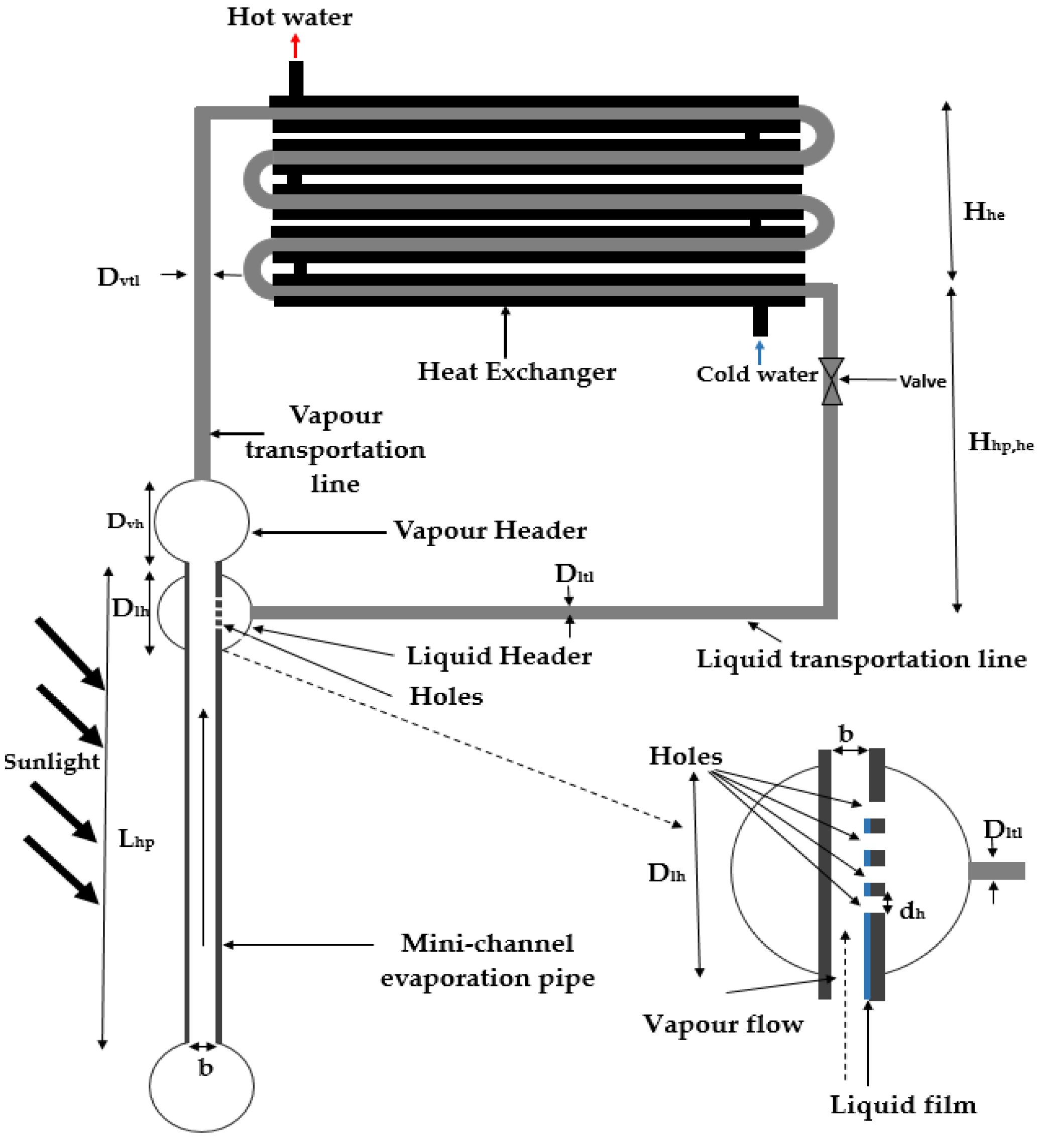
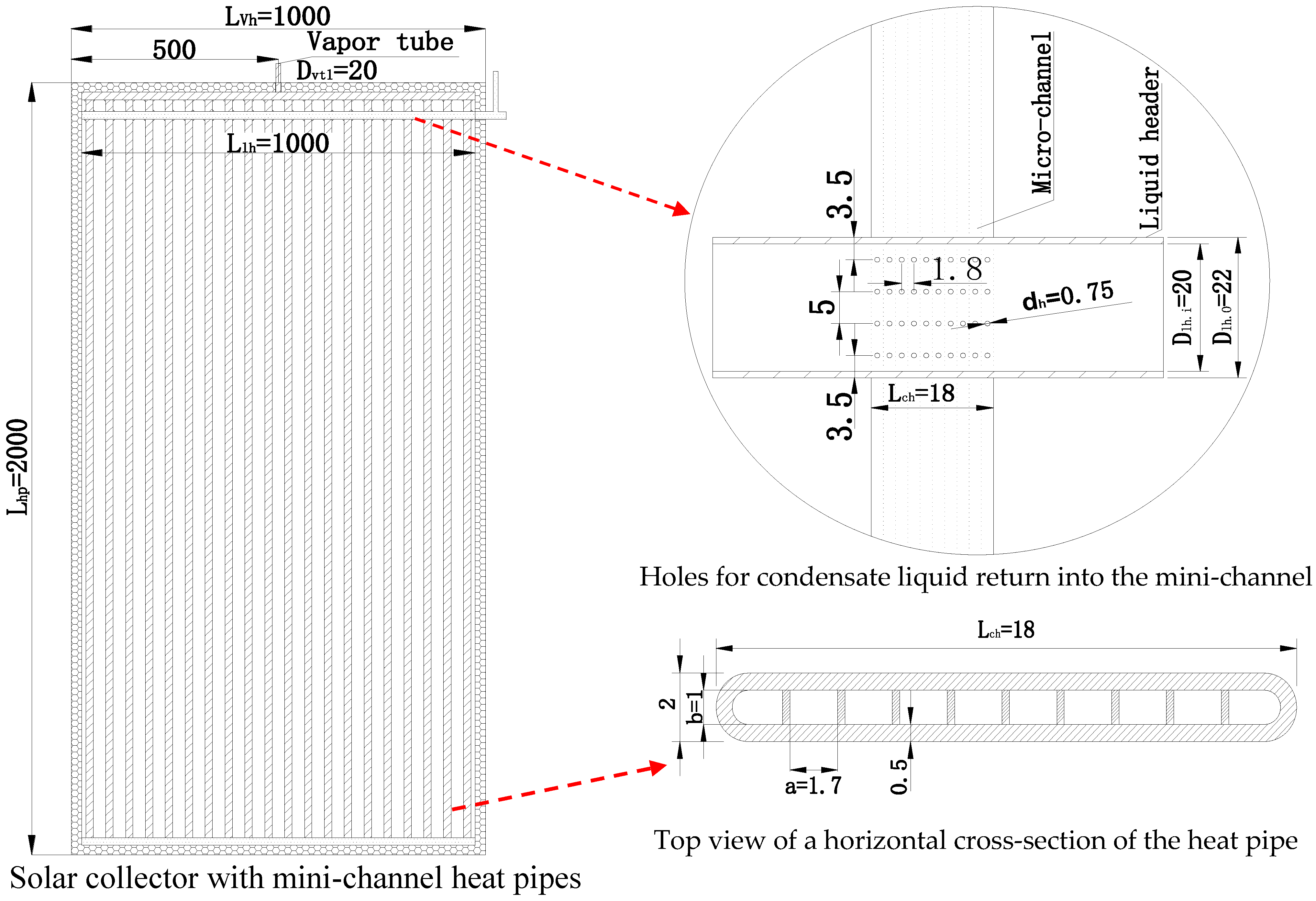
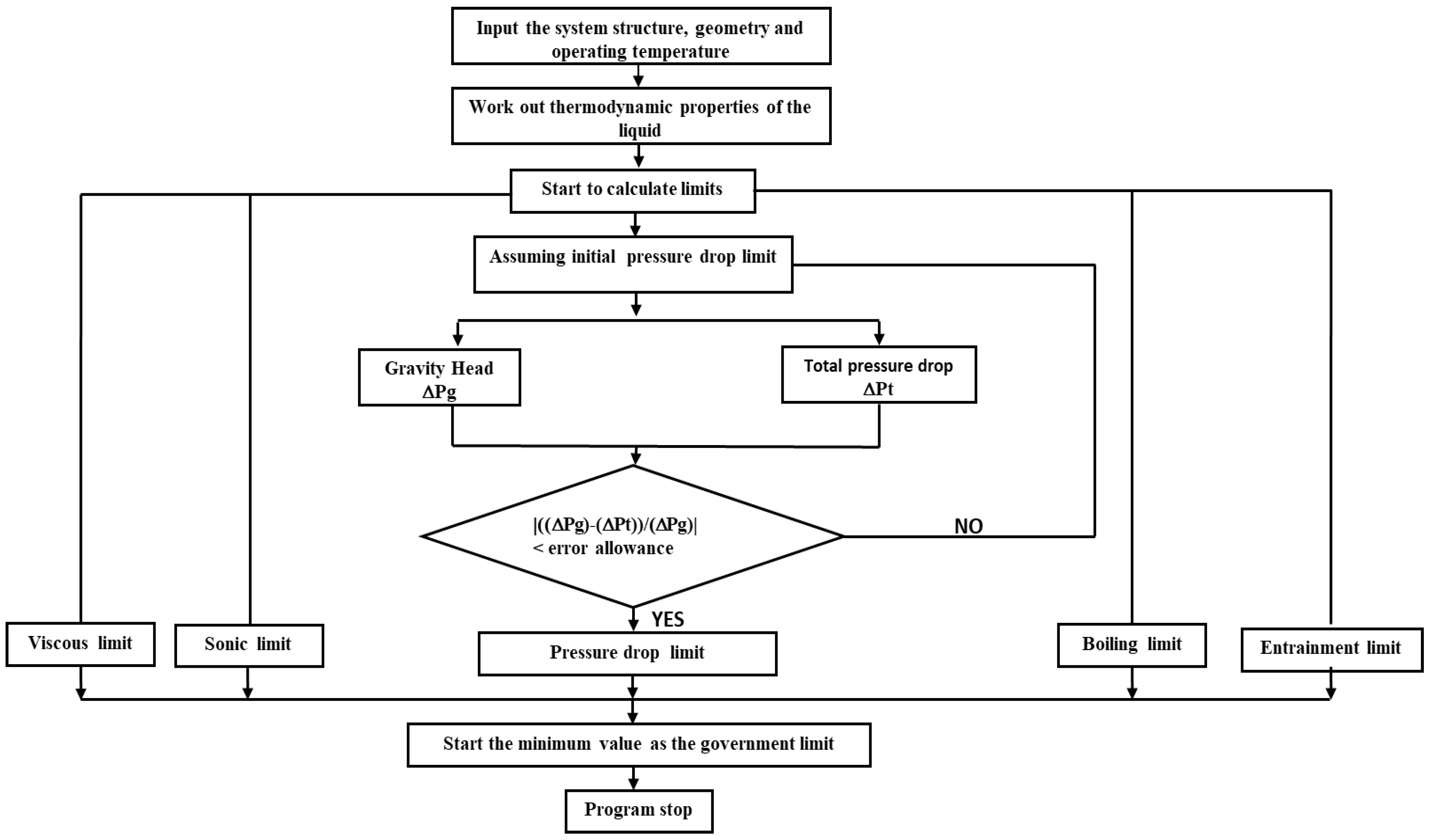
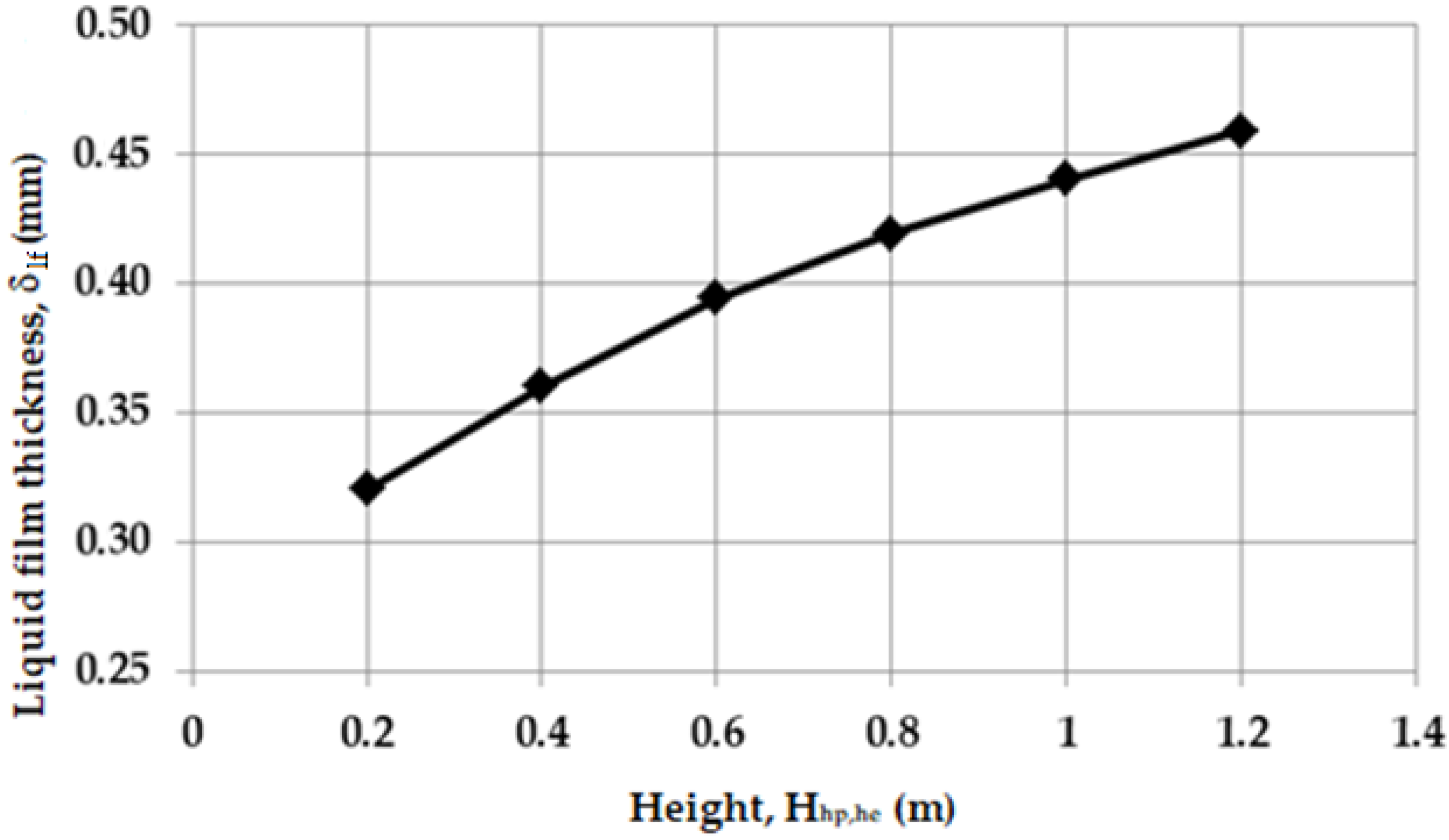
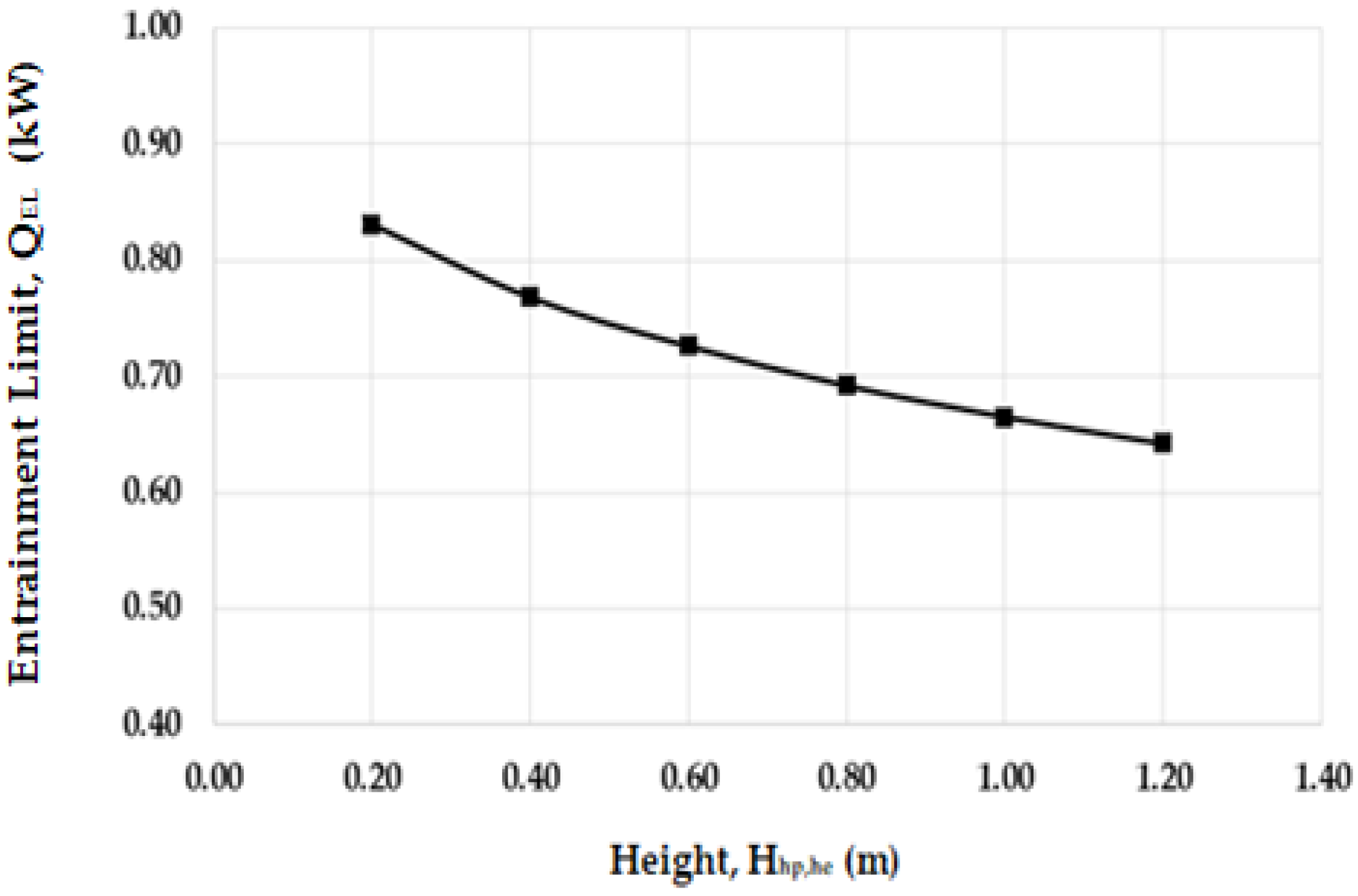
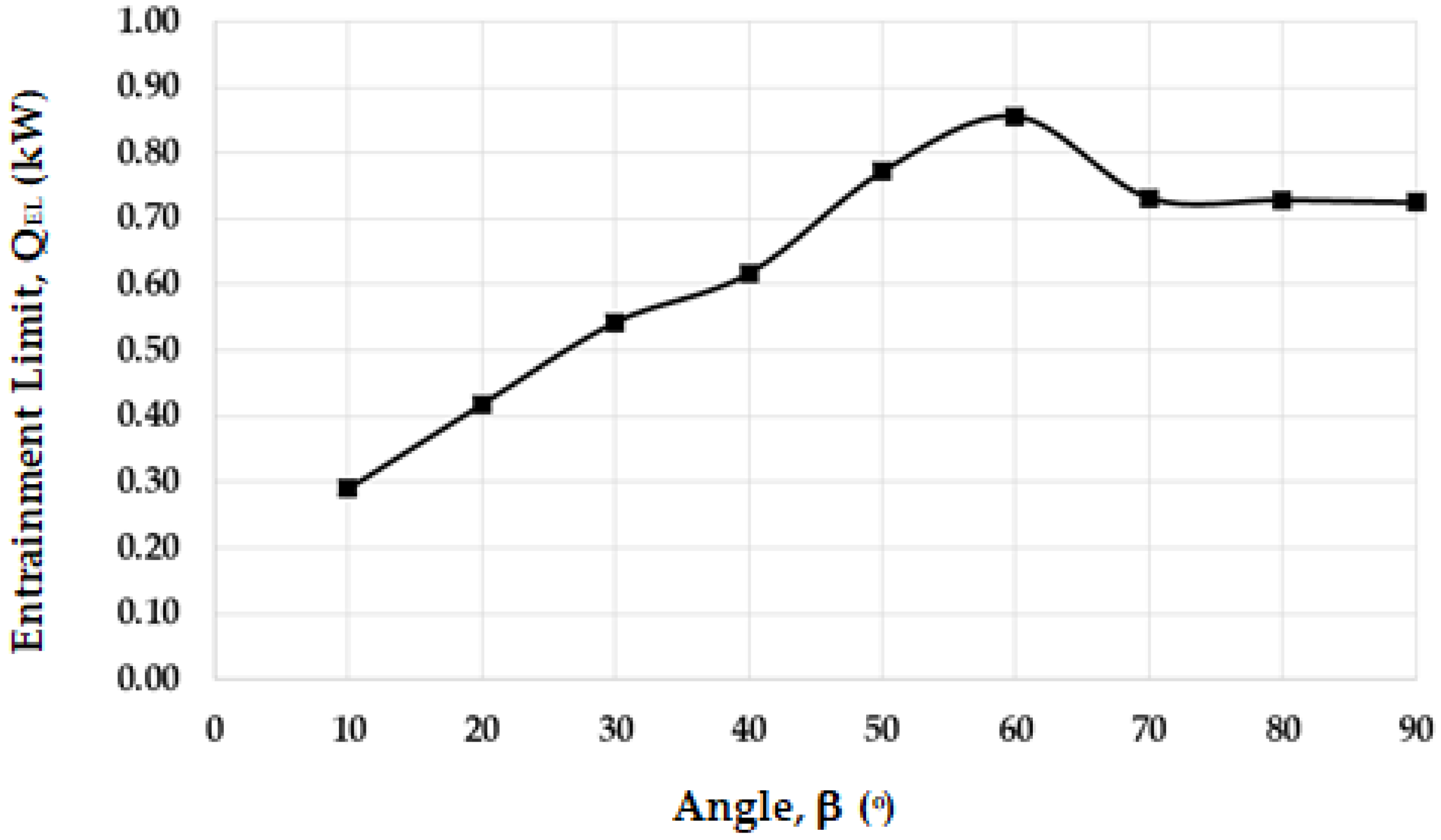
| Parameters | Nomenclature | Value | Unit |
|---|---|---|---|
| Mini-channel port width | a | 0.0017 | m |
| Mini-channel port height | b | 0.001 | m |
| Evaporator length | Lhp | 1.9 | m |
| Number of mini-channel heat pipes | Nhp | 20 | - |
| Number of mini-channel ports | Np | 10 | - |
| Total number of mini-channel ports | Nch | 200 | - |
| Operating temperature range | tv | 20–60 | oC |
| Evaporator-to-condenser height difference | Hhp-he | 0.6 | m |
| Transportation line outer diameter | Dltl,o/Dvtl,o | 0.015 | m |
| Transportation line inner diameter | Dltl,i/Dvtl,i | 0.0174 | m |
| Liquid head length | Llh | 1 | m |
| Liquid head diameter | Dlh | 0.022 | m |
| Vapour header length | Lvh | 1 | m |
| Hole diameter | dh | 0.00075 | m |
| Transportation line length | Lltl/Lvtl | 1/1 | m |
| Heat exchanger central tube total length | Lhe | 5 | m |
| Operating Temperature tv (°C) | Viscous Limit QVL (kW) | Sonic Limit QSL (kW) | Entrainment Limit QEL (kW) | Boiling Limit QBL (kW) | Pressure-Drop Limit QPL (kW) |
|---|---|---|---|---|---|
| 25 | 183.00 | 81.80 | 0.888 | 2.89 | 24.40 |
| 30 | 233.00 | 91.90 | 0.885 | 2.88 | 22.70 |
| 40 | 350.00 | 102.00 | 0.801 | 2.72 | 19.70 |
| 45 | 409.00 | 107.00 | 0.767 | 2.62 | 18.30 |
| 50 | 465.00 | 110.00 | 0.725 | 2.50 | 17.01 |
| 55 | 515.00 | 111.00 | 0.677 | 2.36 | 15.01 |
| 60 | 555.00 | 111.05 | 0.623 | 2.19 | 14.46 |
| Aspect Ratio | b (mm)/a (mm) | Viscous Limit QVL (kW) | Sonic Limit QSL (kW) | Entrainment Limit QEL (kW) | Boiling Limit QBL (kW) | Pressure-Drop Limit QPL (kW) |
|---|---|---|---|---|---|---|
| 0.29 | (0.0005/0.0017) | 3.52 | 21.70 | 0.126 | 1.16 | 4.01 |
| 0.58 | (0.001/0.0017) | 465.00 | 110.00 | 0.725 | 2.50 | 17.01 |
| 0.86 | (0.0015/0.0017) | 2730.00 | 122.00 | 1.455 | 3.88 | 20.20 |
| 1.15 | (0.002/0.0017) | 8230.00 | 122.50 | 2.290 | 5.29 | 30.50 |
| 1.44 | (0.0025/0.0017) | 18,400.00 | 122.50 | 2.370 | 6.71 | 54.40 |
| 1.73 | (0.003/0.0017) | 38,800.00 | 122.50 | 2.371 | 8.14 | 98.19 |
| Height Hhp,he (m) | Viscous Limit QVL (kW) | Sonic Limit QSL (kW) | Entrainment Limit QEL (kW) | Boiling Limit QBL (kW) | Pressure-Drop Limit QPL (kW) |
|---|---|---|---|---|---|
| 0.20 | 699.00 | 122.00 | 0.831 | 2.50 | 17.01 |
| 0.40 | 551.00 | 117.00 | 0.768 | 2.50 | 17.01 |
| 0.60 | 465.00 | 110.00 | 0.725 | 2.50 | 17.01 |
| 0.80 | 404.00 | 105.00 | 0.692 | 2.50 | 17.01 |
| 1.00 | 359.00 | 101.00 | 0.665 | 2.50 | 17.01 |
| 1.20 | 322.00 | 97.80 | 0.642 | 2.50 | 17.01 |
| Hole Diameter dh (mm) | Viscous Limit QVL (kW) | Sonic Limit QSL (kW) | Entrainment Limit QEL (kW) | Boiling Limit QBL (kW) | Pressure-Drop Limit QPL (kW) |
|---|---|---|---|---|---|
| 0.30 | 1090.00 | 122.50 | 0.96 | 2.50 | 17.01 |
| 0.50 | 689.00 | 122.00 | 0.83 | 2.50 | 17.01 |
| 0.75 | 465.00 | 110.00 | 0.73 | 2.50 | 17.01 |
| 1.00 | 141.00 | 74.20 | 0.49 | 2.50 | 17.01 |
| Angle β (°) | Viscous Limit QVL (kW) | Sonic Limit QSL (kW) | Entrainment Limit QEL (kW) | Boiling Limit QBL (kW) | Pressure-Drop Limit QPL (kW) |
|---|---|---|---|---|---|
| 10 | 465.00 | 110.00 | 0.290 | 146.000 | 17.01 |
| 20 | 465.00 | 110.00 | 0.418 | 146.000 | 17.01 |
| 30 | 465.00 | 110.00 | 0.543 | 145.600 | 17.01 |
| 40 | 465.00 | 110.00 | 0.617 | 127.300 | 17.01 |
| 50 | 465.00 | 110.00 | 0.772 | 102.400 | 17.01 |
| 60 | 465.00 | 110.00 | 0.856 | 77.400 | 17.01 |
| 70 | 465.00 | 110.00 | 0.732 | 52.400 | 17.01 |
| 80 | 465.00 | 110.00 | 0.729 | 27.400 | 17.01 |
| 90 | 465.00 | 110.00 | 0.725 | 2.500 | 17.01 |
| Evaporator Length Lhp (m) | Viscous Limit QVL (kW) | Sonic Limit QSL (kW) | Entrainment Limit QEL (kW) | Boiling Limit QBL (kW) | Pressure-Drop Limit QPL (kW) |
|---|---|---|---|---|---|
| 0.50 | 1310.00 | 100.00 | 0.66 | 2.19 | 16.79 |
| 1.00 | 657.00 | 100.00 | 0.66 | 2.34 | 16.94 |
| 1.50 | 488.00 | 100.00 | 0.66 | 2.44 | 16.98 |
| 1.90 | 465.00 | 100.00 | 0.66 | 2.50 | 17.01 |
© 2018 by the authors. Licensee MDPI, Basel, Switzerland. This article is an open access article distributed under the terms and conditions of the Creative Commons Attribution (CC BY) license (http://creativecommons.org/licenses/by/4.0/).
Share and Cite
Diallo, T.M.O.; Yu, M.; Zhou, J.; Zhao, X.; Ji, J.; Hardy, D. Analytical Investigation of the Heat-Transfer Limits of a Novel Solar Loop-Heat Pipe Employing a Mini-Channel Evaporator. Energies 2018, 11, 148. https://doi.org/10.3390/en11010148
Diallo TMO, Yu M, Zhou J, Zhao X, Ji J, Hardy D. Analytical Investigation of the Heat-Transfer Limits of a Novel Solar Loop-Heat Pipe Employing a Mini-Channel Evaporator. Energies. 2018; 11(1):148. https://doi.org/10.3390/en11010148
Chicago/Turabian StyleDiallo, Thierno M. O., Min Yu, Jinzhi Zhou, Xudong Zhao, Jie Ji, and David Hardy. 2018. "Analytical Investigation of the Heat-Transfer Limits of a Novel Solar Loop-Heat Pipe Employing a Mini-Channel Evaporator" Energies 11, no. 1: 148. https://doi.org/10.3390/en11010148







